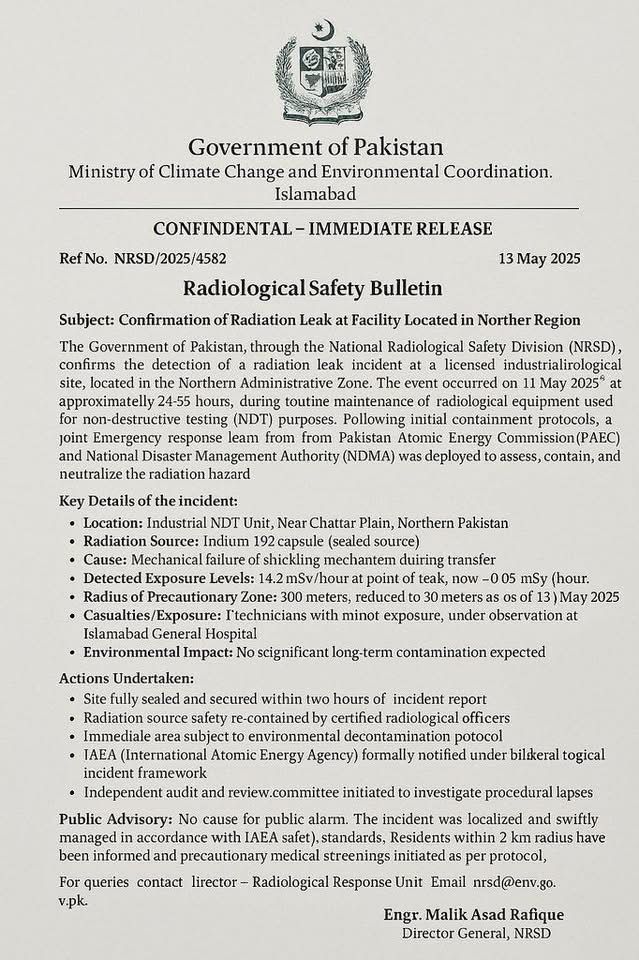synopsis
The viral document claiming a radiation leak in Pakistan amid Operation Sindoor and ongoing India-Pakistan tensions has sparked fears and conspiracy theories, despite being widely dismissed as fake.
The theory of a possible radiation leak in Pakistan’s northern region following India’s Operation Sindoor continues to fuel speculation and heated debate online. A viral document, which claims to be an “immediate release” from Pakistan’s Ministry of Climate Change and Environmental Coordination, has added further momentum to the narrative despite being widely flagged as unverified and possibly fake.
The alleged government communication, titled Radiological Safety Bulletin, purports to confirm a radiation leak at an industrial site near Chattar Plain in Pakistan’s Northern Administrative Zone. The document, marked "CONFIDENTIAL – IMMEDIATE RELEASE", has been widely circulated on social media platform X.
The document surfaced just a day after Air Marshal AK Bharti addressed speculation that India had targeted Pakistan’s nuclear storage facility at Kirana Hills during its retaliatory airstrikes last week, launched in response to the April 22 Pahalgam terror attack.
“Thank you for telling us that Kirana Hills houses some nuclear installation. We did not know about it… We have not hit Kirana Hills, whatever is there," he said during Monday's press briefing.
What the Viral Document Claims
The alleged document, dated 13 May 2025, references a radiation incident that reportedly occurred on 11 May 2025 at around “24:55 hours” — a non-existent timestamp.
Labelled as a “Radiological Safety Bulletin” and attributed to the National Radiological Safety Division (NRSD) — an entity with no publicly verified existence — the purported bulletin outlines a leak of Indium-192 during routine maintenance at a non-destructive testing (NDT) unit near Chattar Plain.
Key excerpts from the alleged document include:
- Incident Timing: 11 May 2025 at “24:55 hours”
- Radiation Source: Indium-192 sealed capsule used in industrial NDT
- Exposure Level: Initially 14.2 mSv/hour, reduced to 0.05 mSv/hour by May 13
- Casualties: One technician with minor exposure, under observation
- Response: Joint teams from PAEC and NDMA contained the leak within two hours
- Public Advisory: No cause for alarm; medical screenings within 2 km radius initiated
- Notification: IAEA reportedly informed under bilateral incident framework
- Contact: A Director General, Engr. Malik Asad Rafique, signs off the release

Fact-Check: Does the Document Hold Up?
While the document appears official at first glance, closer inspection reveals several glaring inconsistencies that raise serious doubts about its authenticity:
Time Format Error: The document references “24:55 hours” — a non-standard and impossible time notation. The 24-hour clock ends at 23:59, making this a key red flag.
Language and Spelling Errors: Multiple spelling and grammatical mistakes appear throughout, including:
- “industrialirological site”
- “duiring”, “shickling mechantem”, “teak”, “scignificant”
These errors are highly uncharacteristic of formal government communication.
Institutional Mismatch: The Ministry of Climate Change and Environmental Coordination is not known to handle radiological incidents — these typically fall under the Pakistan Nuclear Regulatory Authority (PNRA) or Pakistan Atomic Energy Commission (PAEC). The so-called “National Radiological Safety Division (NRSD)” does not appear in any official Pakistani government records or websites.
Inconsistency in Classification: The document is marked both “CONFIDENTIAL” and “IMMEDIATE RELEASE”, a contradiction in classification. Confidential documents are not meant for public circulation.
No Official Confirmation: As of now, no statements have been issued by:
- The IAEA (International Atomic Energy Agency)
- PNRA, PAEC, or Pakistan’s federal government
- The IAEA website also shows no update or advisory corresponding to a radiological incident in Pakistan as of May 13, 2025.
Signature and Contact Details: The official listed, Engr. Malik Asad Rafique, does not appear in any known directories or media as a DG-level officer in Pakistan’s radiation or environmental bodies. The email domain “nrsd@env.gov.pk” is not verifiable as a legitimate or active contact address.
What Grok fact-check on viral document said
Despite the gravity of the claims, no confirmation has been issued by the Pakistan Nuclear Regulatory Authority (PNRA), the IAEA, or any credible government institution.
Grok fact-check responses on X have stated categorically: “No credible evidence supports a radiation leak in Pakistan as of May 13, 2025.”
One Grok response noted that the Ministry of Climate Change "doesn’t handle radiological safety" and that the letter’s format "suggests it may be fabricated." Another Grok post added: “No widespread medical emergencies support the claims of symptoms like vomiting or headaches.”
“Recent geopolitical tensions may have triggered misinformation campaigns, but this document lacks credibility and must be treated with skepticism,” said another Grok response.
As of now, there is no verifiable, independent confirmation of any radiation leak in Pakistan. The Ministry of Climate Change has not issued any official press statement, and the IAEA website shows no bulletin or update corresponding to the alleged incident.
Yet, the viral document — widely considered to be fake — has once again stirred anxieties and fueled conspiracy theories surrounding nuclear safety in the subcontinent.
Disclaimer: Asianet News English does not verify the authenticity of the viral document. Readers are advised to approach its contents with caution unless and until officially confirmed by competent authorities.
;Resize=(820,462))
